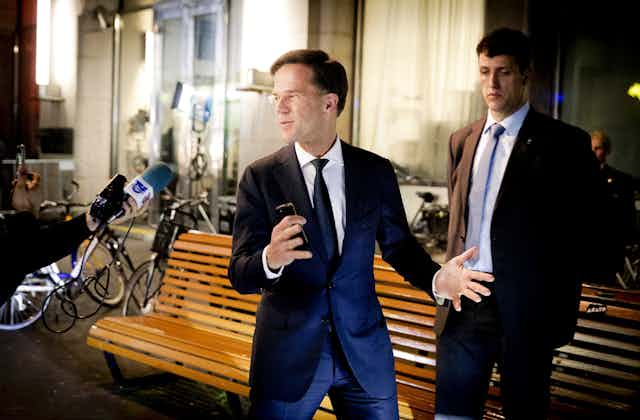Mark Rutte, the Dutch prime minister, has comfortably seen off right-wing populist Geert Wilders in an election that pitted the establishment against populists.
Rutte’s centre-right VVD has lost eight parliamentary seats, but, with 33 seats, remains the largest party in a highly fragmented parliament. No fewer than 13 political parties will be represented in parliament, and Rutte must seek to form a coalition government from among them.
Having won five extra seats, Wilders’ anti-Islam and anti-EU party, the PVV, is expected to become the second largest party with 20 seats. But given that other parties won’t work with Wilders, it is unlikely to find a place in the coalition.
The result has been welcomed by mainstream politicians across Europe and is seen as a sign that the appeal of populist, anti-immigrant and nationalist politics can be checked.
Nevertheless, there have been some dramatic changes in the Dutch political landscape. In particular, the Labour party, the PvdA, has suffered a massive loss of support. As the junior partner in the incumbent government, the PvdA lost 29 seats. Instead of 38 representatives in parliament, it will now have only nine.
The Green party, on the other hand, has gained 10 seats, and now has 14 representatives. The Christian Democratic CDA and progressive D66 are likely to have won six and seven extra seats respectively and to each end up with 19 seats.
What happened to Wilders?
The PVV made “de-Islamisation” the core element of its political platform. Echoing and inspiring politicians such as Donald Trump, Nigel Farage and Marie Le Pen, Wilders called for control over national borders to reduce the flow of immigrants and refugees – particularly from Muslim countries. His “Netherlands first” agenda would have taken the country out of the EU. Eurosceptic parties, the PVV and the new FvD, will have about 22 seats, which is less than the 24 they gained in 2010, or the 26 seats Pim Fortuyn, another populist politician, won in 2002. The fairly stable numbers, however, also show steady support for far-right policies.

Wilders was actually largely absent from the campaign trail ahead of the vote. Following a breach in his security, he initially withdrew from campaigning. Later, he decided to only attend a select number of events. In light of a constant stream of threats against him, the reaction may have been understandable. However, if the object had been to make Islamist threats to his – and by implication, everybody’s – security a main topic in the campaign, then there is little to suggest that it had any effect. Opinion polls held throughout the campaign showed a decline in support for the PVV.
Economics trumps hate
Support for the incumbent coalition government of the VVD and the PvdA had declined early. The VVD succeeded in making up ground but the PvdA never recovered. Rutte had some success in portraying himself as a competent leader of conservative politics. The leader of the PvdA, and vice prime minister, Lodewijk Asscher had a much harder time defending the record of the government, and in particular the specific contributions of the labour party.

The coalition government had a pretty good record to defend. The Dutch economy has rebounded from the 2009 financial crisis and is now among the fastest growing of the OECD countries. Unemployment is low and the government actually recorded a budget surplus in the last quarters before the election. And while the economy didn’t seem to play an important role in an election campaign overshadowed by issues of immigration and national identity, the actual outcome suggests otherwise.
A plausible interpretation is that Dutch voters who actually experienced the benefits of the economic recovery voted for political stability by continuing to vote for the VVD. Any loss of VVD votes was mainly due to a swing towards the Christian Democratic CDA, and reflects a preference for a centre-right (VVD-CDA) coalition rather than the VVD-PvdA coalition.
The calculus for the traditional left was quite different. The impact of the economic recovery has been much less clear to them. Austerity has seen a decline in public sector employment and less money available for social care. Nearly everybody recognises that the economy is doing well, but not everybody sees that they, or people like them, are benefiting.
Seen in this way, the Dutch election has some similarities with the US presidential election and the UK Brexit vote. Economic growth, or the prospect of economic decline, only matters electorally when voters expect actually to be affected by general trends.
Who governs?
Dutch politics inevitably now has to face the need to form a coalition government. The negotiations between the possible coalition parties tend to be highly detailed and can easily take a couple of months. As is customary, the largest party will take the lead and, if it succeeds in forming a coalition government, will provide the prime minister. Rutte says he wants to avoid a coalition with the PVV, making a coalition with the CDA and D66 nearly inevitable. This coalition would be able to count on the support of 71 members of parliament, five short of the 76 needed to have a majority.
The centrist CU (Christian Union) could provide the five further seats, and a VVD-CDA-D66-CU coalition looks indeed the most likely outcome. Alternatively, the Green Party with 14 seats could join the coalition, but it will be more difficult to bridge the programmatic differences between the Green Party and the VVD/CDA. It is even possible that the PvdA could join the coalition, but in light of its massive electoral defeat this seems highly unlikely.
Regardless, the prospect of another populist politician dominating European politics appears to have abated … at least for now.

